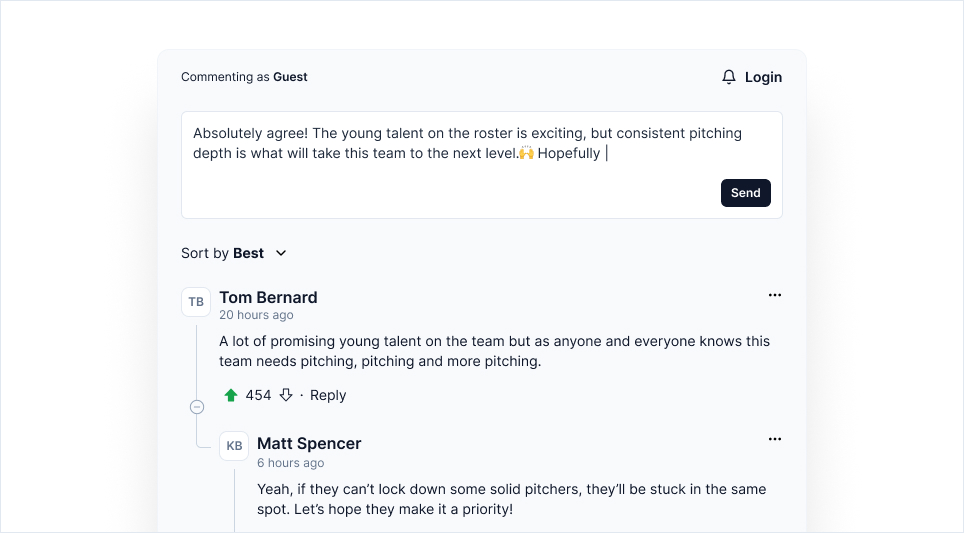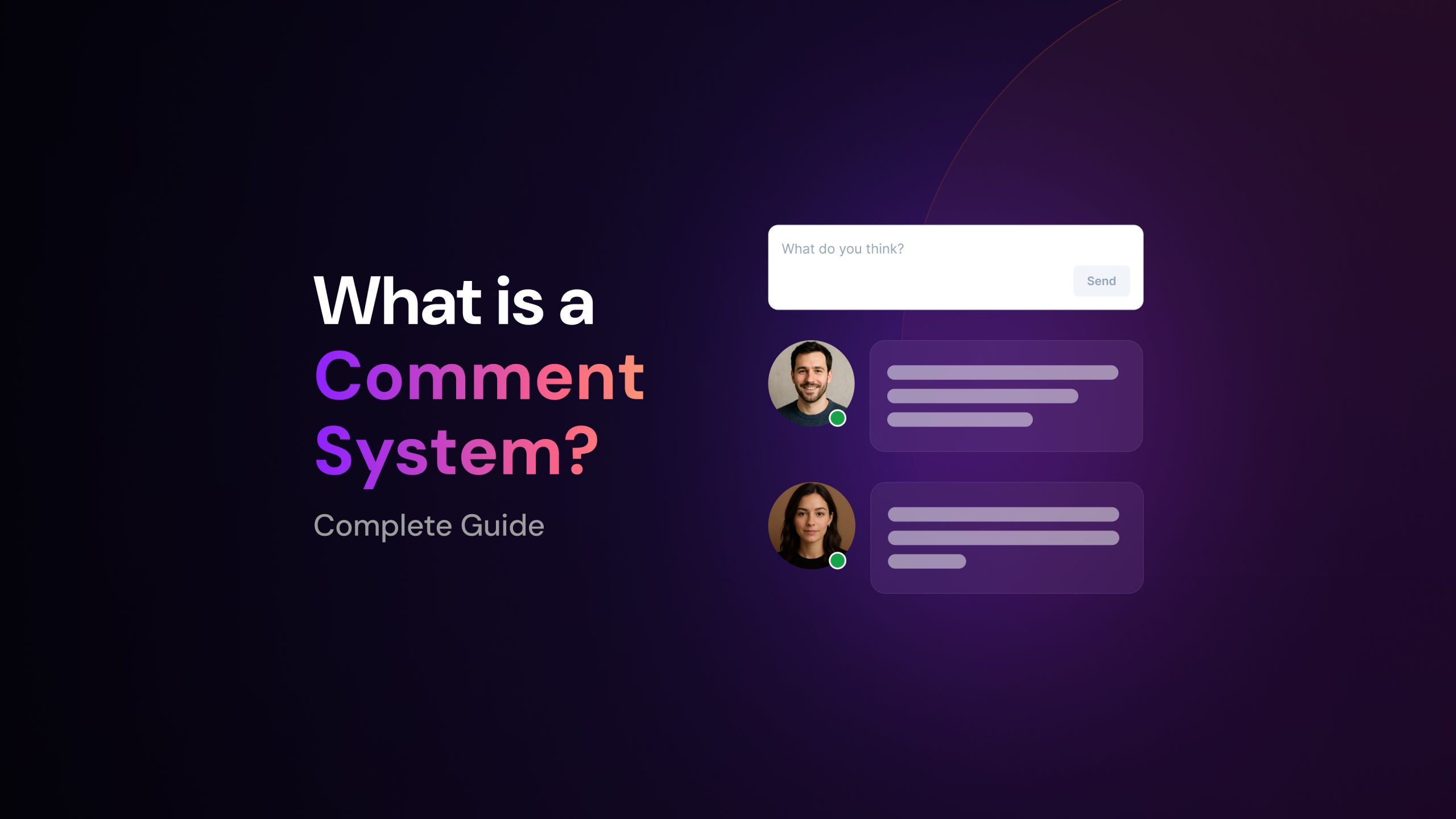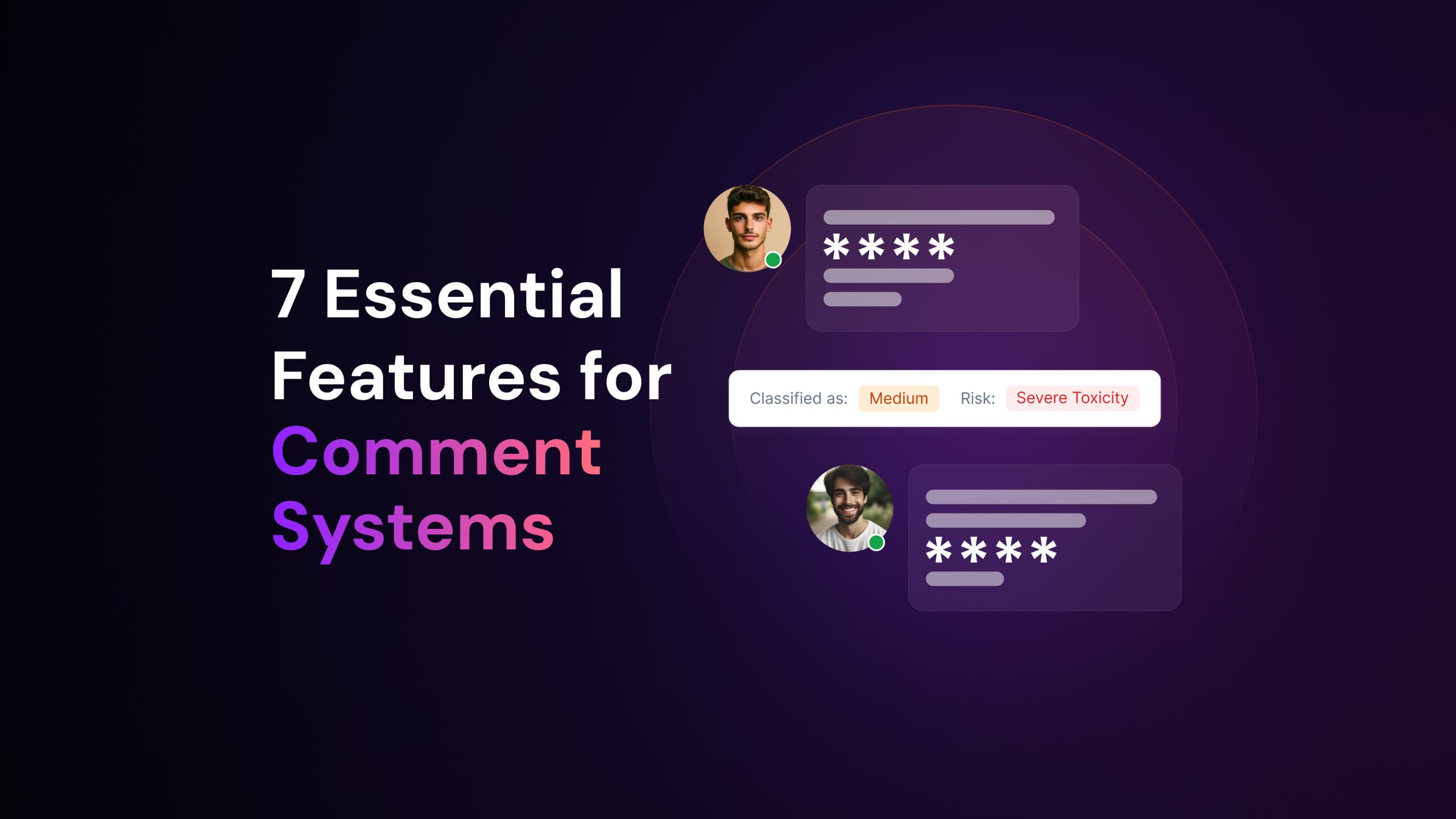Brands, creators, and publishers are always looking for new and innovative ways to increase audience retention and engagement. One of the most overlooked strategies lies in a simple feature included in all social media platforms: the comment section.
However, incorporating this feature into a website isn’t always straightforward, as most sites require third-party platforms, called comment systems, to enable user comments.
In this guide, we will guide you to understand what is a comment system, how it works, what the most essential features are, which analytics to keep track of, and more.
What is a Comment System?
Simply put, a comment system is a tool integrated into websites, blogs, or other online platforms that allows users to leave comments, share opinions, and engage in conversations directly beneath published content.
Also known as a commenting system, these platforms serve as a bridge between brands, content creators, and news media, as well as their respective audiences, fostering interaction, community building, and user engagement.

Why is a Comment System Important?
Besides allowing readers to interact with their favorite brands, creators, and sites, a commenting platform plays a vital role in enhancing a website’s credibility and visibility. By enabling real-time interactions and discussions, they increase the time users spend on the page, boost SEO with user-generated content, and provide detailed audience insights.
By hosting discussions on their websites, publishers and brands maintain control over audience interactions, avoiding the limitations of social media platforms and fostering healthy conversations with moderation capabilities.
How do Comment Systems Work?
Comment systems work as a structured way for users to submit, display, and interact directly on a website or blog. When a user types a comment and clicks “submit”, the commenting system captures that interaction and processes it according to predefined criteria. The website’s administrator establishes these rules, typically including spam detection, moderation workflows, and user authentication protocols, to ensure the quality and security of interactions.
Once the comment is processed, it is stored in a database and dynamically displayed on the comment section, usually displayed chronologically or by relevance. Some modern comment systems support real-time updates, allowing new comments to appear instantly, without requiring the user to refresh the page.
Advanced commenting platforms rely on built-in moderation tools, including flagging inappropriate content, blocking users, and spam filtering, among others. Additionally, comment systems enable administrators to integrate comments with social media platforms or single sign-on (SSO) services, allowing users to comment using existing profiles, reducing friction and encouraging participation.
Overall, we can say that a comment system acts as both a technical infrastructure and a social layer, creating space for meaningful interactions between content creators and their audiences.
Key Features of Modern Comment Systems
Modern comment systems have evolved into sophisticated community engagement tools featuring advanced capabilities. They go far beyond simple text boxes, offering features that help website owners create safe and dynamic spaces for discussions.
Below are some of the most important features you should look for when looking for a comment system:
Intelligent Moderation & Security
The internet is filled with trolls and bots, ready to flood interactive spaces with foul words and inappropriate comments. That is why content moderation is so important when it comes to comment systems.
When looking for a commenting tool, make sure it comes with built-in moderation capabilities. These systems use sentiment analysis to detect inappropriate comments and support customizable moderation workflows for different content types.
Beyond manual moderation, your chosen platform should ideally have AI-powered content moderation that automatically filters spam and toxic content while maintaining high-quality discussions. You can set up automated rules while maintaining manual oversight for sensitive discussions.

Real-time Engagement Features
Although this isn’t an industry standard, modern comment systems deliver instant comments without page refreshes. Comments appear immediately, and some systems even have live presence indicators that show active participants. Users receive instant notifications when someone replies to their comments or mentions them, fostering dynamic conversations and keeping discussions active.
Look for comment platforms that include social reactions to comments, upvotes and downvotes. This focus on real-time engagement is crucial for maintaining an active community. Moreover, features designed to enhance engagement keep users invested in the conversation.
Rich Media within Comments
Comments can go way beyond text, especially when you are working with advanced commenting systems. Look for platforms that allow users to embed and upload images, GIFs, and videos in their comments.
Another way to enrich your comment section is by enabling users to format their comments using markdown, adding clickable links with preview cards, and tagging others using @mentions, all of which make conversations more dynamic and interactive.
These capabilities not only encourage richer dialogue but also make the comment section feel more like a real-time chat. In addition, social media integration allows users to easily share content or conversations, helping to amplify engagement and extend your community’s reach beyond the page.
Smart Threading & Organization
Comment threads help organize discussions, allowing users to follow the conversation easily. Modern comment systems nest comments in clear hierarchies, with collapsible threads to manage long conversations. Multiple sorting options allow users to view the discussion by newest, most popular, or most relevant content, while maintaining context integrity.

Seamless User Authentication
One of the benefits of integrating a comment system into your website or blog is capturing readers’ first-party data through user authentication tools. Users can sign in through social media, email, or SSO (Single Sign-On) systems.
Beyond helping maintain security, profile systems help build community identity through customizable avatars, reputation scores, and user history, encouraging user participation while avoiding low-quality contributions.
Data and Analytics
Everything you do and add to your website must be aligned with your marketing strategy, and with comments, it’s no different. When choosing your comment system, look for platforms that provide detailed engagement metrics, ideally displayed on a comprehensive dashboard.
Look for platforms that allow you to track comment volumes, identify top contributors, analyze sentiment trends, measure community health, and display monetization metrics such as engagement-driven revenue, clicks on affiliate links, and more. Having this information at hand allows you to gain deeper insights into your audience, empowering you to make data-driven decisions.
How to Choose the Right Comment System
When considering adding a comment section to websites and blogs, some people might opt for what their CMS (content management system) natively offers. It might be enough for them, but for brands, publishers, and creators who wish to deliver the best experience for their audience, a robust third-party platform will ultimately be the best choice.
Choosing the right comment system isn’t just about ticking off a feature checklist, but rather deciding on a platform that aligns with your audience’s needs, content type, and business goals.
Here are some key considerations when evaluating a comment system for your website:
What’s Most Important to Your Audience?
Users want a seamless experience when interacting with your content. The interface should be clean, intuitive, and responsive across all devices. Commenting, replying, and engaging with others should feel effortless, with minimal steps required to participate. That’s why choosing platforms that count with SSO and social media authentication is a good way to encourage reader interaction.
How Sophisticated Should Your Moderation Be?
We’ve said it before, but it is worth mentioning again: moderation is key when it comes to comments.
Advanced commenting platforms count on robust moderation capabilities, such as word filtering, automated spam detection, user blocking, and moderation queues for manual review. These tools help maintain a respectful and safe environment, allowing meaningful conversations to thrive while minimizing the risk of abuse, trolling, or off-topic content.
Is Your Content Fast-Paced or Timeless?
The nature of your content should influence the comment system you choose. For fast-moving or live content, real-time comment updates and presence indicators help keep engagement active and ongoing. For evergreen articles, threaded discussions and sorting options offer better clarity and structure.
Is the Comment System Able to Scale With You?
Your platform should grow with you. Ensure it can handle traffic spikes, high comment volumes, and integrate seamlessly with your content management system (CMS) or technology stack. Scalability, performance, and flexibility are essential if you expect your audience to expand over time.
Does the Platform Allow You to Monetize Engagement?
Comment systems can go beyond discussions; they can be powerful revenue streams. Some systems allow you to insert native ads or sponsored content directly into comment threads, blending monetization with community interaction. Others support affiliate links, allowing publishers and creators to earn from product mentions or recommendations within discussions.
Comment System Analytics and Insights
Monitor Key Metrics
Your comment system should track essential engagement metrics, including:
- Comment volume and frequency
- User participation rates
- Response times
- Thread depth and conversation length
- Peak activity periods
- Most engaging content types
- Top contributors and their patterns
These metrics help identify what drives meaningful conversations in your community. For instance, a high thread depth, which involves multiple replies in a conversation, often indicates engaging topics that resonate with your audience.
Gain Actionable Insights
Comment analytics can reveal valuable patterns for decision-making. When you notice specific topics consistently generating deeper discussions, you can adjust your content strategy by exploring new themes that align with your audience’s interests.
Robust comment systems can handle high commenting activity, with some processing up to 1 billion comments daily from 100 million active users. The significant volume of data enables sophisticated trend analysis and pattern recognition. You can identify your most engaged community members, understand what drives participation, and spot potential issues before they impact community health.
The data from your comment system also provides competitive advantages over social media platforms. Unlike third-party platforms, you maintain full ownership of this engagement data, allowing for deeper analysis of your community’s behavior and preferences over time.
Next Steps to Elevate Your Comment Section
Comment systems serve as a fundamental bridge between passive content consumption and active community participation, helping your website or blog transform into a vibrant engagement hub.
For businesses seeking to foster stronger connections with their audience, comment systems offer a strategic pathway to bring social media discussions into their owned online spaces. And the starting point for making this happen is choosing the right comment system platform for your website.
Arena Comment System is a robust platform that empowers brands, creators, and publishers to build engaged communities, foster meaningful conversations, and drive measurable impact through real-time, interactive comment experiences. Click here and try Arena for free today!


